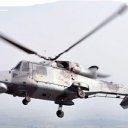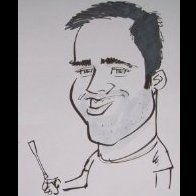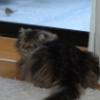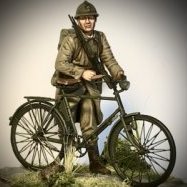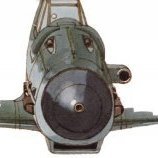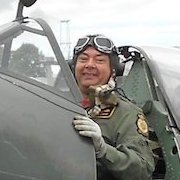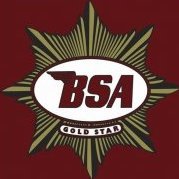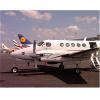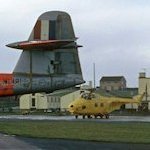Search the Community
Showing results for tags 'Az models'.
-
Here's my first contribution to the GB. The strangely configured Beech Staggerwing which I'll be building as a Fleet Air Arm Traveller MkI. The boxing gives 4 options, an RAF, FAA (it does say RAF but the Royal Navy ID over the serial sort of gives it away), Finish and Chinese Nationalist options. Mine will be the FAA option in the US blues. Obligtaory sprue shot. Single sprue with minimal flash and most things reasonably well moulded but only time will tell. Nice transfer sheet and two tiny transparency sprues. And typical AZ instruction sheet showing vaguely where things go. Though to be fair on the other side there is a rigging diagram.
-
Time to throw my hat into the ring! The Fairey Fulmar was designed in response to a specification for a naval carrier-borne fighter/reconnaissance/observation aircraft. It was a navalised development of the Fairey submission for a replacement for the Battle (specification P.4/34) which was, in turn, a smaller version of the Battle itself - hence the family resemblance. I've heard it referred to as a 'Battle in a swimming costume' or similar, which amused me no end - so I've shamelessly pinched and bastardised that for my thread title Seeing heavy use in the fighting in the Mediterranean, the Fulmar was too large and heavy to be an effective fighter against single seat fighter opposition, due to the Admiralty's insistence on a second crewmember for navigation and wireless operator duties. They had made the (correct) assumption that, as Nazi Germany possessed no carrier force, it would not come up against carrier-borne fighter opposition. This seems to have led to the (wildly incorrect) assumption that it would come up against absolutely no real fighter opposition at all; most likely (in my mind) wishful thinking to ensure that the specifications fit their preconceived notions of naval warfare in which everything was all about big gun battleships and aircraft were but a sideshow. It's a pity that it took events like the sinking of Repulse and Prince of Wales to shake the mostly-gunnery branch senior officers out of their complacency. Serving as the FAA's primary fighter from 1941-1942 and equipping 20 squadrons at their peak, Fulmars flew from eight fleet and five escort carriers from the Arctic to the Far East, shooting down 112 enemy aircraft for the loss of 40 of their own in combat, making it (despite the drawbacks) the FAA's leading fighter by victories in the war. They performed a wide range of duties including reconnaissance, spotting, escort, intercept, patrol and guiding flights of Spitfire and Hurricane reinforcements on the long flights to Malta. Replaced as day fighters from 1942 onwards by Sea Hurricanes, Seafires and Martlets, the Fulmar soldiered on in reconnaissance, intruder, night convoy escort, night fighter and training roles until withdrawal in February 1945. (Factual info lifted from Wikipedia, the grumpy opinions are my own!) The kit: Opening the box, I was pleasantly surprised to find a PE fret and some resin wheels as part of the base kit; I was also a bit taken aback by how big it is as, despite knowing that its overly-large stature was one of its shortcomings, I think I had it in my head as about Typhoon-sized. The resin wheels are an optional part, and the instructions say to use them according to the photos of one's chosen prototype; they look to have smaller hubs and chunkier tyres than the injection moulded ones, and the implication is that's deliberate. I'll have to do some research, but they'll need a little cleaning up before use as the spokes don't look that crisp: This was going to be an OOB build... but I don't think I can live with the neon decals (Mossie included for comparison purposes): It's something I've noticed with the relatively few KP and AZ models that I've done so far - the colours of the decals all seem a little off. I've got some spare Type B, C and C1 roundels and could probably get away with the code letters as is, but I was originally planning to do the version in type A/A1 roundels, when it was still very much in first line service as a fighter. Hannants do a couple of Xtradecal sheets which include the Fulmar, I'll have to do a bit of digging to see if I can turn up info on whether the profiles are correct; failing that, I may be able to turn up some sources of roundel decals and other identification codes. On the other hand, if anyone can recommend the correct paints for identification red (dull), identification blue (dull) and identification yellow, and makers of masks, I might well be willing to try out painting my own...
-
I think I read somewhere that AZ Model's kit is based on the older Pavla kit, does someone know if this is true? That would mean that the PE set from Brengun should also fit the older Pavla kit.
- 8 replies
-
- p-26a peashooter
- Pavla Models
-
(and 1 more)
Tagged with:
-
Yokosuka D4Y1/1-C Judy (AZ7841) 1:72 AZ Model by Kovozávody Prostějov Intended as a replacement to the ageing Aichi Val, the Suisei, or Comet in English, was delayed by development issues that meant the Val had to soldier-on in service, where it racked up a substantial tally of Allied ships and other assets in the dive-bomber role. Initially powered by a license-built Daimler Benz DB601 engine, the aircraft had a high top-speed that gave it an advantage when avoiding defensive fighter screens on the way to the target, but like many Japanese designs, it lacked armour and self-sealing fuel-tanks that meant one burst of fire stood a good chance of turning it into a flaming wreck. It wasn’t until the later radial-engined 4 variant that such niceties as armoured glass and cockpit protection were introduced, too little, too late, as all the experienced pilots had already met their doom. Although it was intended as a dive bomber, its speed led to its use as reconnaissance aircraft, and late in the war it was also used in kamikaze attacks, having the unfortunate distinction of being the aircraft used in the last attack of the kind of WWII, ironically just after the Japanese surrender documents had been signed. It was equipped with a pair of forward-firing .303 machine guns throughout its service, and a rear machine gun for the gunner in the back of the long greenhouse canopy, which was upgraded to a more powerful 13mm weapon in later variants to improve its destructive capability. Its bomb load was only 500kg, often stored in the internal bomb bay, or as two 250kg bombs under the wings. The Kamikaze variant carried 800kg, as it wasn’t expected to make a return journey. The D4Y4 was the last version that appears to have been tuned towards the unique requirements of kamikaze attacks, having its rear gun removed, the bomb load increased, plus frontal and cockpit armour added, along with some protection for the fuel tanks. The end of the war curtailed the development of the D4Y5 that mounted a more powerful 2,000hp radial engine and a four-bladed prop. The Kit This is a reboxing of a kit that was originally tooled in 2012, although additional parts have been added since then, and a new decal sheet is provided for this issue. It arrives in an end-opening box, with a painting of the type on the front having just sent an American Wildcat spiralling on a journey to the ground in flames. A full set of profiles can be found on the rear of the box, using Gunze paint codes to call out painting instructions. Inside the box are two sprues of grey styrene, a sprue of clear parts in its own Ziploc bag, decal sheet and instruction booklet, all tightly wrapped in a resealable clear foil bag to prevent chaffing of the parts. The instructions consist of an A5 booklet of two pages of folded A4, with spot colour on the front page, and a set of stencil profiles on the rear. Detail is good, with crisp engraved lines on the surface, and plenty of raised and recessed details incorporated on the sprues. Construction begins with the cockpit, which is assembled on a long flat floor with a raised portion in the middle that accepts the pilot’s seat and decal seatbelts, adding the control column in front, and painting the moulded-in rudder pedals. In the rear section, a single tall bottle and a rack of three more squat bottles are inserted into depressions, as is a box, and later on the rear crew seat on a rotating gun-mount frame with more decal belts applied is fitted in front of the box, and is shown facing forward. In between the crew are two radio black boxes that are fixed to the upstand behind the pilot’s seat and on the floor just behind it. There is mention of Photo-Etch (PE) parts for the instrument panel, but this is a generic Judy instruction sheet, and refers to another boxing. The styrene instrument panel is blank, and has two decals applied to depict the dials instead of the PE, and these should be applied after painting the panel, as the dials are printed on a clear carrier film. The cockpit and instrument panel are sandwiched between the two fuselage halves along with the tail wheel, and here there is some ribbing and other detail moulded into the interior that will benefit from some careful painting to accentuate them. The lower wing is a single-span part that incorporates part of the lower fuselage, and this has the two gear bays inserted from within along with a clear window in the cockpit floor before it is joined to the upper wings and mated with the fuselage. The gear bays also have some ribbing moulded-in to add detail to your model, as well as sockets for the gear legs that are installed later. First, a choice of large or small tail fins is butt-jointed with the fuselage, as are the elevators, and all these would benefit from pinning for extra strength, even at this scale. The larger fin is appropriate for this boxing, so toss part 8 into the spares bin early on to avoid confusion. Both cowling types are included on the sprues, but you can ignore step 9 for this issue, as the early Judys had in-line engines. The cowling is made from two halves, into which the exhaust stacks are slotted into grooves at the sides, adding the three-part chin intake below, then applying the spinner to the three-bladed prop and inserting the shaft into the hole in the nose. The diagrams all have their appropriate variants included in text on the left, so making a mistake would require some effort to ignore them, which is good. The main gear is next to be made, fitting the wheels to the end of the struts, and adding the captive bay door over the open side to trap the wheel in place, doing the same in mirror-image for the other leg. It is worth noting however that the upper end of the bay door should be cut off to create a small additional door that rests almost flat against the wing once installed, so cut those before you glue them to the legs. A few scrap diagrams help you with the correct alignment of the parts, and show the angle for the inner bay doors. A small pair of doors are fitted to the tail gear bay, with an arrestor hook only fitted to certain options, due to a dwindling number of carriers the Japanese navy possessed nearer the end of the war. There is a common roll-over bar with V-brace support fitted between the cockpits, then a choice of guns for a couple of specialised sub-variants can be ignored, as can three of the four canopy steps, taking note of step 18, which has the canopy installed in the front of the cockpit cut-out with a telescopic sight projecting through a hole in the glass, and a single part for the rest of the greenhouse, adding a radio mast at around the mid-point of the framework, for which you’ll need to provide your own wire/thread to connect it to the top of the tail fin, as per the top diagram of the stencil profiles. Markings There are four options on the decal sheet, and although they all wear the same green over grey camouflage with a wiggly demarcation, their other markings are different enough to be interesting. From the box you can build one of the following: The decals have been designed by Rising Decals, and appear to be printed using the same digital processes as Eduard are now using, having good registration, sharpness, and colour density, with a thin gloss carrier film cut loosely around the printed areas. I mention Eduard because from 2021, the carrier film on their decals can be coaxed away from the printed part of the decal after they have been applied, effectively rendering them carrier film free, making the completed decals much thinner and more realistic, and obviating the need to apply successive coats of clear varnish to hide the edges of the carrier film. It’s a great step further in realism from my point of view, and saves a good quantity of precious modelling time into the bargain. Conclusion A welcome re-release of this initial version of the Judy that is well-detailed, and from my own point of view is a more attractive option than the later radial-engined options. What amounts to carrier film-free decals also adds to the appeal. Highly recommended. Review sample courtesy of
-
Here is the result of my tangle with the AZ Models X-3 Stiletto. I read hsr's thread about his experiences with this very kit and was both inspired and terrified. As expected, there were some terrible fits (canopy, exhaust), but the shape is generally good and there is nice engraved detail. Canopy masks from Peewit fit great. I tried to create a worn version of this aircraft, as it appears in later photos. Tamiya and Alclad paints, and weathered with enamels and oils. A straight pin was substituted for the nose boom because if any of my models is going to impale someone, it's going to be one called Stiletto. Too bad this thing was so damn slow! Thanks for looking!
-

AZ Model Grumman G36 Grumman Martlet MK.1
Slywolff posted a topic in Ready for Inspection - Aircraft
Hi there After seeing Grumman Martlet AL426 at the FAA Museum in Yeovilton I tried to get hold of the AZ kit but at that time it was out of production, so I posted on Hyperscale in the Wants section for this kit for trade, an American modeller kindly sent me his kit minus one aircraft decal set, at no cost which was hugely generous! I have painted and added markings for a Grumman aircraft as painted, I mixed the light green using Humbrol paints. It is a kit that needs some attention and work to make it presentable. AL426 A mass of photos of AL426 collected for the build. I mixed these two Humbrol tins to get the light green. -
So just finished this one, my first ever biplane. The build thread is here but to recap: Kit: AZ Models 1/72 Martinsyde F4 Buzzard Build: OOB Decals: Painted except for the fuselage codes. Paints: Tamiya, Klear, oils for fading Extras: Pilot from spares, rigging (badly) from invisible mending thread This year is the centenary of the Irish Air Corps and the Buzzard entered service in the summer of 1922. They were the first aircraft and single seat fighter of the new force. This build was definitely NOT my best! The fit was terrible, some of the parts horrible. And then the 'rigging' was an absolute bear 🙄. My favourite part is probably the oil fading and how the prop turned out. I think I learned more while bodging this kit together than any other kit I've made. Anyhow, some pics and learned lots for the next biplane! Thanks for looking and happy modelling. Dermot
- 7 replies
-
- 22
-

-
- AZ Models
- Irish Air Corps
-
(and 1 more)
Tagged with:
-
Has anyone built any of the new(ish) AZ 1/72nd Bell AH-1G Huey Cobra series of kits? A search of Google didn’t bring up any worthwhile comments – have I missed any reviews? Many thanks
- 36 replies
-
- helicopers
- AH-1G
-
(and 2 more)
Tagged with:
-
Hi there I have built a few Spitfires in the past and Jørn, a local IPMS member, recently gave me an AZ Models Seafang. As I had an Airfix Mk 1 on the shelf with a 2 bladed prop I thought I would build them at the same time. The Airfix Spit has pretty deep panl lines so these were filled with Milliput before building commenced. Here are the parts I started with. On close up the main Spitfire parts look like this: And here are the Seafang parts: Shown in the picture above is the extended carburetor intake to go under the nose that came from a Special Hobby Seafire FR 47. This will replace the moulded nose from the Seafang kit that compares as shown below: I am working on the basis of my glass being half full with the Seafang. Other useful bits that will be donated by the Seafire FR 47 include the spinner and the tail plane. A set of SBS exhausts have also arrived. Major surgery was performed to reve the AZ tail and replace it with the Seafire one. Here is my homemade jig to get the rudder post of the transplanted tail square with the fueslage thrust line. Tha picture above also shows the main wing assembly. The Spitfire is in the paint shop at the moment. With the aount of filler needed on the joints has me thinking if I build another Mk 1 Spitfire, I will use the AZ-H Airfix kit that came out a good few years ago. More to follow Regards Toby
-
I’m going to throw my hat in the ring with this one that’s been in the stash a while not decided on markings yet but the big orange fun bus on the box art does appeal for some reason
-
My first aircraft completion since April, the AZ Model Bf 109F competed out of the box as an aircraft captured by 1 Squadron SAAF in Libya, 1942. Intended as a quick build using what paints I had, so can only be considered a representation. Brush painted with Tamiya and Italeri acrylics, made grubby with oils and finished with a brushed on coat of Italeri acrylic flat clear. Build thread can be found here. Nice, easy, quick build - very relaxing way to ease into the vacation. Thanks for looking and Seasons Greetings to all!
-
It’s been a long time since I have done an aircraft build thread, but with the start of the summer vacation, and making progress on some vehicles this last week I felt like getting back to aircraft. My local hobby shop has just had a big restock, and in amongst the new kits was this. The box top scheme really tickled my fancy, so I grabbed one. Looks reasonably straightforward: Plan is to do a straightforward quick build over the weekend before the Christmas shenanigans starts. I’m going to make due with the paints I have in stock, so it may be that the colours will be a bit off. So, making a start at 10 am after the Saturday morning chores, first job is to glue all the parts of the cockpit using Tamiya extra thin cement. After a quick check with the exhausts, it looks like they can be added later from the outside. Just in case, I glued some plastic card on the inside so when I do add them I don’t push them all the way through by accident. Then on with some paint with brushes, using Tamiya XF-24 for the inside of the cockpit. The propeller hub received a coat of Tamiya X-7. That’s the state of play at 12 noon.
-
I would like to enter this GB with this Bf 109, that flew over the Agäis December 1943. Cheers Jes
- 10 replies
-
- 10
-

-

AZ Models 1/72 Spitfire Tr.9 (Elizabeth)
davebruce posted a topic in Ready for Inspection - Aircraft
Evening all, First of all I must thank @Deanflyer for all of his help on this build as without him I would not have been able to reproduce this aircraft. I present to you today the AZ models 1/72 spitfire Tr.9 dressed up in the colours of NH341 Elizabeth. The model is built as a gift for my brother who was lucky enough to have a fly in and fly, for a bit this plane for his 50th birthday. I was originally going to build the brigade conversion but @Deanflyer was happy to let one of his spare AZ ones go to a new home and he also let me have the template for me to print off my own decals for the nose, code, squadron crest and kill score markings, plus some masks for the fuselage letters. Thanks again Dean! The build itself was a little more of a challenge as I'm only used to airfix and revell. There are no locator pins anywhere on the kit and the wing tips and tail elevators are all butt joints. No tabs! Plenty of filling and sanding to be done but enjoyed the build and pleased with how it has turned out. Plus its going to be in a case so most mistakes will be hidden, result!. As always, thanks for looking.- 21 replies
-
- 49
-

-
- Spitfire Tr.9
- AZ Models
-
(and 1 more)
Tagged with:
-
Here's a quick build, bit of stash busting and refresher while I wait for decals for something quite a bit bigger. AZ Models 1/72 Bf 109G-14 Wr.Nu.462919 "Weisse 7". I find the blotted out insignia and no frills scheme (no colourful ID or unit markings at all) to be quite menacing in its monotone. Erla mottling is quite hard to execute in this scale though, at least my wife likes it and calls it my "leopard print plane". Anyway, for a "quick and dirty" project I'm fairly pleased with the outcome, any tips are welcome 🙂 I would also like some colour feedback please. For some time my standard RLM 74/75/76 schemes have been done using Xtracrylix. But recently I have been questioning the amount of effort I put into getting good results brush painting them, and whether their RLM 74 looks too green. Now, without opening the usual can of worms on this, I wanted to use more generic paints and see how a standard scheme aircraft would look with more neutral greys, as these colours were often perceived especially from a distance. Final picture for comparison (both "White 7" by coincidence) is with a Tamiya G-6 finished in Xtracrylix. For this build, the main colours used are: RLM 74 - Humbrol 32 RLM 75 - Humbrol 27 RLM 76 - Revell Aqua 76 (a pleasant coincidence) Thank's for taking a look!
-
Possibly not the most approrpiate build to post on VE day but it's Bank holiday and I have time to take pictures, so here it is: my recently completed Bf 109G-6 of the Royal Hungarian Air Force "Red Puma" squadron. Couldn't resist the colourful tail on this one! The kit is 1/72 AZ Models "Danubian users" boxing but I adapted the camouflage and ID markings as I was suspicious of the box art instructions showing a non-standard scheme I could not verify. So here it is in standard German (WNF) pattern. I had some slight mishaps with sections of the vinyl mask lifting where the canopy is curved so I got primer on the transparent parts, but it seemes to have cleared up OK after scraping off and applying varnish. All hand painted except the primer layer. Main camouflage colours are Xtracrylix, rest is Humbrol or Revell. For some reason the RLM 74 always comes out looking far lighter and more green when I take pictures of my models than how I see them. I like how the Xtracrylix brush on and how they look on the model on my shelf, but not so much how they turn out in pictures! Oh well! I'm terrified to ask if anyone can vouch for their colour accuracy because I don't want to go through learning to brush paint yet another brand. Thanks for looking!
-
Now this is a bit different. I picked this up several years ago on a visit to Hannants at Colindale as I noticed one of the liveries provided was for a Royal Navy glider. I recalled that I had it a few days ago and thought if I could dig it out of the stash it would be a quick build and get done now I'm almost finished my other contributions. It's only got 11 parts and a canopy, pretty much one colour, no etch, no resin and only 4 transfers to go on. So it was found in a pile on the top shelf and out it came. A simple simple set of instructions on one page. The colour call outs are in Czech but google translate helped out and the two I couldn't translate aren't used anyway. Simple sprue, the big problem is a number of fairly big ejection pins including one on each wing. Small but comprehensive transfer sheet and tiny clear sprue with a canopy and something else which doesn't appear on the instructions.
- 17 replies
-
- 2
-

-
- Royal Navy
- AZ Models
-
(and 1 more)
Tagged with:
-
Hello all, After my bit of silliness with the Mustang, I'm back to a serious build again. I was recently asked if I would build a replica of the two seat Spitfire T.9 named Elizabeth, which can often be seen in the summer months fulfilling peoples' bucket list ambitions by getting them in the air in a Spit, flying from Headcorn or Sywell. Here she is, photographed by the talented Ian Amis: Ultimately this model will end up in the hands of Keith Perkins, the owner of Elizabeth, so I'd better make a good job of it! I used the AZ Models T.8/9 kit in 1/72, which is pretty much the only game in town for two seaters unless you have the 1/48 Brigade Models conversion set (I have 🙂) or are willing to do a LOT of scratchbuilding in 1/32 and convert a single seater yourself (I did 🙂). It's a short run kit with all the shortcomings that that implies - dubious fit, no locating pins or tabs and numerous moulding flaws such as an ejector post mark right on the fuselage behind the rear canopy. The boxing I had also only came with Dutch or Irish markings, so I had to buy an aftermarket set of decals for a Mk.IX Spitfire to get the right stencils and roundels for an RAF machine. Typically, the day after I'd bought these, AZ brought out a new boxing of the kit, with markings for several of the currently airworthy warbirds! At Telford, I also bought a set of resin wheels of the three spoke variety, as most modern warbirds use these post war wheels these days...not Elizabeth though, oh no! She's still wearing her four spokers, which are provided in the kit anyway. Should have checked, really... Also, having checked my decal stash, none of the RAF fonts used for squadron codes matched the decidedly non standard font used on Elizabeth, so working from photos, a friend of mine was good enough to use his profile cutter to custom cut some masks for the RB*E for me - thanks Nige! The canopies on this kit are pretty thick and there is no option for posing them open, so although there is a fair bit of detail in the cockpit virtually none of it will be visible after the lids go on. I kept the interior detailing basic, using the kit decals for the instrument panels, and confining the painting to some black details and a dark wash, although I did add some seatbelts from masking tape: The airframe goes together pretty quickly, but as the kit this was based on was a clipped wing Spit, the kit's wingtips have to be carefully removed and the elliptical wingtips glued on. As mentioned before, this short run kit has no tabs or pins, and the wingtips are a straight butt joint onto the wing. There's hardly any land for them to attach to, and as a result this will be a weak point on the model. I'll have to inform the owner not to pick it up by the wingtip, or he'll be looking at a pile of wreckage with a chagrined expression on his face - not for the first time either! The most laborious bit of the build is the filling and sanding specified in the instructions...the cartridge ejection chutes under the wings have to be filled and sanded flush without losing the surrounding detail, the cannon and machine gun ports have to be filled (I used plastic rod glued into the holes and sanded flush) the two halves of the carburettor air intake scoop are a terrible fit needing putty right down the middle, the rear glazed portion of the front canopy isn't deep enough, so I had to build up the fuselage it attaches to with plastic strip, and the rear windscreen stands so wildly proud of the fuselage it almost seems to be a different scale! The rear canopy is a pretty abysmal fit all round really, and a lot of scraping down, carving to fit and puttying was used to get it anywhere near fitting. Still, mustn't grumble... 😉 Once the inevitable rounds of putty-sand-repeat had been dealt with, a primer coat was used to detect any further surface blemishes - and there were a few! Then it was time for a bit of head scratching - Elizabeth proudly bears her name in curly cursive script on the side of the port cowling, in white - trying to do white decals is the bane of a modeller's life, as you can't print white on a printer. I considered using white decal film, but experiences with this in the past have showed that the stuff is so thick it'd look like the name had been riveted onto the airframe attached to a steel plate! My solution was to take a photograph of the name, reduce it to the right size by trial and error, and then print it on clear decal film. The appropriate spot on the model could then be painted white, the decal attached to allow the white to show through as the lettering, and then the non white bits touched up with the right camo colour. Sounds complicated, but it worked ok. I also did the same for the squadron crest and the two kill markings below the windscreen: You can also see in the above photo the masks on the fuselage sides - I painted the area Sky for the theatre band and the letters, applied the masks, and then applied the camo on top. Again, the camo had to be patterned as best I could from reference photos, as no two modern restorations are the same, and differ from standard wartime plans. I was trying to get the demarcations to pass over the canopies in the right places, through the squadron codes in the right places, and so on. Easier said than done, but the little details matter. All in all, when the masking came off, I was satisfied enough, with just one or two areas needing touch ups: Then, just as the last touch ups had been done to my satisfaction, the wingtip fell off. It was bound to happen sooner or later, and it did. Ooh, such expletives. It's a good job I live alone, as the the sort of language emanating from my workroom would frighten children and animals, tarnish silver and bruise fruit. ^+^£%$%* butt joints! One invisible repair and respray later, and the airframe was ready for a gloss coat ready for decals. That's how it stands at the moment, all shiny: More when it happens, Dean
- 37 replies
-
- 24
-

-
Here is my third contributio, AZ Model's version of the first FAA model of the Martlet/Wildcat. These were aircraft redirected from Belgian and French orders for, at that time, the new Wildcat. They differ in they were engined with a Wright Cyclone engine and on arrival in the UK had to have their equipment changed to British equipment. Three options offered, including an erroneous RAF version, I'm also not sure that this livery is correct and the serial is definitely wrong. I'll look in the transfers stash and see if I have something more accurate. There are about 30 parts on two sprues, moulding is not too bad at times but there's a bit of flash and some pretty large moulding pins. Also there's a resin engine and a small clear sprue with a canopy and the two underside windows. Simple instructions. Some of the colour call outs are not right. Especially some of the interior colours and the undercarriage. And a nice transfer sheet albeit with probably wrong serials for the British one. Now to get some paint on.
-
I have wanted to build an FAA aircraft with folded wings for a while, originally I fancied a Barracuda but I came across the AZ Models Fairey Fulmar which a bit of research and some very helpful info from Britmodeller members told me was an ex Revell mould with some updates. Hannants do the Airwaves folding wing etch for the Revell Fulmar and I decided to take the plunge. The box art is a little underwhelming not a patch on the original Revell box art and I dont think a Fulmar ever flew in a emerald green camo job. IMG_20200302_114736924 by Stuart, on Flickr I was a little disapointed by the instructions which are of the "glue all parts together" variety there is very little actual construction detail and the sprues take some working out which part is which. IMG_20200302_114855414 by Stuart, on Flickr Rather than start with the cockpit as is traditional I decided I would get the wings cut up into the component parts to make the folding wing and get the etched parts all fitting nicely. My reasoning if I make a complete pigs ear of the folded wings I can bin the lot and start something else without spending time on anything else. IMG_20200302_114926075 by Stuart, on Flickr IMG_20200302_124846062 by Stuart, on Flickr The plastic used by AZ is horrible stuff to try and cut cleanly its soft, slippery and the scalpel blade seems to push the plastic away rather than cut it, a couple of times the scalpel wandered off line even though I was using a straight edge the blade just seemed to wander off on its own. One panel took a lot of cutting because of the thickness and the plastic tore rather than snapping when I bent it backwards and forwards around the score line. Started assembling the wings and the Airwaves etch doesnt quite match the wing thickness but other wise the length of the etches seems okay IMG_20200302_140354154 by Stuart, on Flickr
-
I'm going to step cautiously into this one with what I hope will be a simple build (said that before!), just have hardly got any modelling done so far this year. I have a few of the ' -'hawk' series but fancy doing this one. Haven't fully decided which scheme, erring towards the Green/ Dark Earth one, but I'll decide as I go. The obligatory box and sprue shot's, hopefully should be getting going very soon, not child-minding Grandkid's this week!
-
Ah entry of mine over in the P-40 (and relatives!) STGB. Built OOB, not too bad to put together, very nicely detailed, especially the panel lines. Just usual lack of clear placement instructions and tricky fit, re; undercarriage and clear parts. Vallejo ModelAir used throughout, I think it looks quite good in Dark Green/Dark Earth over Medium Sea Grey (?colour call out on the instructions, couldn't confirm this but went for it). 'Klear' gloss coat with Vallejo matt finish. Didn't attempt to scratch build the ring and bead gunsight, not with my shakey hands! looks the part I reckon, what'ya think? Davey.
-
I have finally finished the pair of Pfalzen. The first, an ICM E.IV was built a few years ago and got damaged during my relocation. I decided that the restoration would be more interesting if I took the AZ Models E.I out of the stash and built that alongside it, so that's what I did. They are both 1:72 scale, and both heavily modified from the basic kit. The E.I has scratchbuilt wings and tail surfaces, while the E.IV's are heavily modified kit parts, and both have scratchbuilt undercarriage. Part PE was used for the E.IV guns and the E.I has a MiniWorld gun. Here's the build log for anyone interested. Before the war, Pfalz had obtained a licence to built Morane-Saulniers, and that's what they continued to do after the war broke out. (It is said they made good on every penny they owed M-S after the war!). So all the early Pfalz aircraft were basically Moranes, and that is what they were called by the German pilots who flew them. They were also called "flying death notices", due not just to their black outlined wings and fuselages, but also because they were regarded as "difficult" and the early models suffered quite a few tailplane structural failures, many with fatal consequences. The E.I had an 80hp Oberursel U.0 rotary engine and the various models following that basically had bigger engines and wings, to the E.IV which had a 160hp Oberursel U.III engine. There were a few E.Vs with in line engines but that was basically it as Pfalz had not put any effort into designing their own aircraft and by mid 1916 the old M-S design was well outdated. The company continued on building aircraft under licence from other manufacturers (Roland for example) but they did not build their own aircraft again until the D.III came into service in 1917. The E.I depicted here served in Vilna (Vilnius, Lithuania). The serial number on the fuselage is correct as per photos, at least on the port side. I'm not sure if the way I have shown it on the right side is correct as I had to move the cross forward slightly. It would make more sense to have the "/15" in front of the cross, but who knows whether it was or not. The E.IV depicts an aircraft flown by Rudolf Bertholt whilst with Kampfeinsitzer (literally battle single-seater) Kommando, Vaux, based in Vaux, on the Somme, France in April 1916. He suffered serious injuries when the Pfalz reputation caught up with him and he spun it in from 100 metres. He survived that, and quite a few other injuries received during the war, only to be killed in political street fighting in Hamburg in 1920. He was so badly beaten he couldn't be identified physically. I guess that's what you get when the civilians you're shooting at catch you! Anyway, here they are... They look quite comfortable next to each other in the cabinet! I hope you like them! Ian
-
Due to summer 'distractions' this is not going to be a quick thread, but I'll try to keep you amused with occasional updates. The starting point is an Airfix 1/72 Chipmunk T.10 that I built way back in 1969, shortly after the kit was released; WK574, Cambridge UAS, c 1952 by Philip Pain, on Flickr I have never been happy with the look or accuracy of this kit, but at the time my skill only ran to doing something to correct the canopy, substituting the 'canadian option' windscreen which doesn't have an external frame at the front (it is internal on the real aircraft). WK574, Cambridge UAS, c 1952 by Philip Pain, on Flickr The model is showing its age and the transfers have yellowed. In this view it can be seen that I added the missing flap actuation hinges. WK574, Cambridge UAS, c 1952 by Philip Pain, on Flickr The main problem with the 'look' of the Airfix Chipmunk is that it doesn't have enough 'chin' at the front, also the propellor spinner is too short and bulbous. The intakes on the sides of the engine also too bulbous. WK574, Cambridge UAS, c 1952 by Philip Pain, on Flickr The other big problem is the undercarraige legs which are far too slim, and the wheels don't look right either, being too 'square'. WK574, Cambridge UAS, c 1952 by Philip Pain, on Flickr The cockpit has two seats and nothing else, so I added scratch-built instrument panels. WK574, Cambridge UAS, c 1952 by Philip Pain, on Flickr All of the raised rivets were rubbed down, not that they shouldn't be there, but they were far too prominent. I made a mistake with painting the yellow 'T-bands', they don't go on to the flaps. So I was delighted when AZ Models recently released a new 1/72 Chipmunk kit, and the box promises much; Chipmunk T.10 (1) w by Philip Pain, on Flickr Chipmunk T.10 (2) w by Philip Pain, on Flickr The contents were less inspiring, but seemed ok Chipmunk T.10 (4) w by Philip Pain, on Flickr It is a typical 'short-run' kit, a bit rough around the edges, and generally lacking mounting pins and tabs, making it hard to glue together at times. Chipmunk T.10 (7) w by Philip Pain, on Flickr It has a full cockpit interior, but a familiar problem soon became apparent - once again the canopy is wrong! External frames front and rear, don't Chipmunk mould makers ever go and look at the real thing!? The AZ Models canopy is actually worse than the original Airfix one, because the windscreen is too long with the main frame set too far back. So I've tried to disguise this fault by extending the forward instrument coaming to fill the gap. Chipmunk T.10 (8) w by Philip Pain, on Flickr So here is the basic assembly, and there were big gaps to be filled with modelling putty. Chipmunk T.10 (9) w by Philip Pain, on Flickr Also on the tail, and the spin-recovery strakes were a bitch to get right due to their small size, and vague fit. Also it should be completely flat from one tailplane to the other, but the AZ model has a raised rear fuselage in between. This took a lot of whittling down. So I was starting to lose faith with this model, so I dug out one of my un-built original Airfix kits, to compare notes and check out the differences; Chipmunk T.10 (10) w by Philip Pain, on Flickr And then I couldn't help but start making the Airfix one as well! This time using the AZ model as a guide to correct the Airfix one. Chipmunk T.10 (11) w by Philip Pain, on Flickr Added a basic interior to the Airfix one, and scratch built a pair of spin-recovery strakes for the back end. The Airfix kit also has an annoying feature at the back end, with the tailplanes split where there isn't a split on the real thing. This takes careful filling and sanding to get the required flat finish from one side to the other. But basically the Airfix main parts go together well, with smaller and better aligned gaps. Chipmunk T.10 (12) w by Philip Pain, on Flickr Using the AZ kit as a guide, the incorrect Airfix nose, spinner, and undercarraige legs were then improved using modelling putty. In this photo they still need a bit of finishing off. Chipmunk T.10 (13) w by Philip Pain, on Flickr So now there are two, roughly similar. The front instrument coaming on the Airfix Chipmunk (right) has also been extended, just to make it look better. Chipmunk T.10 (14) w by Philip Pain, on Flickr Chipmunk T.10 (15) w by Philip Pain, on Flickr Here are the two canopies, AZ on the left. Both have had the front and rear external frames filed off and re-polished. Also being made are the two prominent internal frames to go in the rear of each canopy, both absent from the kits. I'm not looking forward to gluing them in place, as there is no room for error with glue and transparencies. So that is the progress, so far.
- 23 replies
-
- 19
-

-

-
Hi all, Not very often I get to post two new builds in a week, but here goes...at the Biggin Hill Heritage Hangar, Spitfire MJ772 has recently been restored and repainted in new livery, prior to its return to flight. I was recently asked to build a model of this particular airframe for Greg Davis, the chap who runs The Two Seat Spitfire Page on FaceBook, who has a growing collection of 1/72 Spitfire T9s. As per usual, the AZ Models kit was used in the absence of any other available kit, and just a few minor tweaks were made. The rear canopy bow is moulded way too thick on the kit part, scaling out at around a foot wide and several inches proud of the perspex, so I carved it off, sanded it down, polished it back to clarity, dipped it in Klear and then masked it to paint a much thinner bow. I think it was a small improvement worth making. The invasion stripes were a pain to mask, taking over two hours for these alone, and the decals were a mixture of Xtradecal for the roundels and code letters and home printed for the serial numbers. The Cross of Lorraine on the cockpit side was assembled from a blue shield shape cut from a scrap Argentinian flag decal from an Airfix Canberra, and three smaller red strips which started life as a wing walk line on a Hasegawa Zero! Lining those up properly on a shield 3mm across was a challenge...😵 The paint used was Tamiya acrylics, and a panel line wash was added to the movable and removable bits only - engine cowlings, flaps, ailerons, elevators, trim tabs etc. I resisted doing a panel line wash all over as in such a small scale it just looks overdone. Final finish was done in Xtracrylix Flat Varnish, after which the canopies were unmasked, the wingtip lights were painted in, the whip aerial under the wing was added and the final touch was to add the propeller - something which always signals the end of the build for me. Special thanks go to CedB on here, for sending me his surplus prop decals - saved me a lot of hassle printing my own! Cheers, old boy. You'll be glad to know that it survived the postal service journey to it's new owner, and he seems pleased with it, which is what it's all about really... Here's a walk around: And a couple of flyaround shots: Now, what's next...? 😉 Dean
- 12 replies
-
- 38
-


